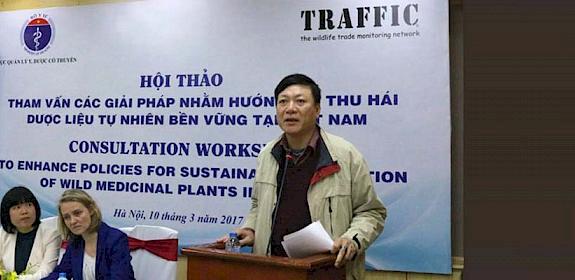Implementation of CITES trade measures for medicinal and aromatic plants
Geneva, Switzerland, 27th August 2019—medicinal and aromatic plants were in the spotlight this week at the 18th Conference of the Parties to the Convention on International Trade in Endangered Species of Wild Fauna and Flora (CITES CoP18) during a debate on implementation of the Convention for these species. CITES provides an important, and sometimes the only form of regulation for trade in some species of medicinal and aromatic plants (MAPs).
Over 60,000 plant species are used globally for medicinal purposes, and about 3,000 are in international trade. Between 60-90% of these species are sourced from the wild. To date, the IUCN Red List assessment has only covered 7% of the species, among which 20% are threatened with extinction in the wild with excessive trade one of the critical drivers.
A document submitted to CITES CoP18 provides an overview of the trade in MAPs and highlights that more than 800 species are listed in Appendix II of the Convention.
Legal trade in wild-sourced CITES-listed MAPs between 2006 and 2015 totalled around 25 million kg. The species traded in the biggest volumes included:
• Candelilla Euphorbia antisyphilitica, used frequently in lipsticks, and other consumer products
• African Cherry Prunus africana, used in medicines
• Aloe spp., used widely as medicinal, food and cosmetic ingredients
• Dendrobium spp, orchids used for medicinal and cosmetic purposes
• Agarwood Aquilaria spp, popular in incenses, aromatherapy and cosmetics
• and Jatamansi Nardostachys grandiflora (based on exporter reported trade data) used in cosmetics, food and in medicines.
Key exporting countries, representing three-quarters of all wild-sourced exports, were Mexico, Cameroon and South Africa, with five countries responsible for 77% of imports: France, USA, Japan, Germany, and Spain.
During CITES CoP18, government parties considered decisions related to managing the complex trade patterns in this diverse taxonomic group of species. During the discussions, TRAFFIC and the IUCN Medicinal Plant Specialist Group (IUCN MPSG) recommended the inclusion of work on aromatic plant species, such as Nardostachys grandiflora, Euphorbia antisyphilitica, Aloe ferox, and not limiting the new measures to species specifically traded for their medicinal properties. The suggestion was met favourably by delegates.
“These new CITES decisions foresee the first steps to strengthen CITES implementation along the entire trade chain for medicinal and aromatic plant species. They also mandate a comprehensive review of a potential long-term workplan on these taxa by the CITES Plants Committee,” said Tom de Meulenaer, head of the Scientific Services team in the CITES Secretariat.
TRAFFIC, IUCN MPSG and others have developed a range of specialised tools specifically to support CITES implementation for managing trade in medicinal and aromatic plants. They include the FairWild Standard—the best practice guidance on sustainable wild-harvesting and trade in wild plants. Non-Detriment Finding (NDF) Guidance for Perennial Plants developed by TRAFFIC and the German Federal Agency for Nature Conservation (Bundesamt für Naturschutz, BfN) facilitates NDF determinations using a straightforward nine-step process.
These tools are being put into practice through a UK Government Darwin Initiative project supporting CITES implementation for Appendix-II listed medicinal and aromatic plant species that is piloting FairWild certification for trade in Jatamansi Nardostachys grandiflora.
TRAFFIC, in collaboration with BfN, other Parties and stakeholders, has also been carrying out work on the potential for voluntary certification standards to support the implementation of CITES for wild-sourced Appendix II listed medicinal and aromatic plant species. The work is summarised in one of the Information Documents available at CITES CoP18.
“This decision and others at CoP18, linked to the improved implementation of CITES to ensure sustainable and legal trade in species, provides opportunities for increased benefits to conservation and livelihoods from international wildlife trade,” said Anastasiya Timoshyna, Senior Programme Coordinator – Sustainable Trade for TRAFFIC, and a Co-Chair of the IUCN MPSG.

![The African Cherry of Prunus africana has a wide range of medicinal uses © David J. Stang [CC BY-SA 4.0]](/site/assets/files/12389/prunus_africana_6zz-david-j-stang-cc-by-sa-4_0.-1800w.1566893635.jpg)


